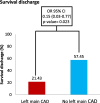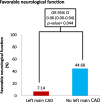Risk factors for sudden cardiac arrest in patients with ST-segment elevation myocardial infarction: a retrospective cohort study
- PMID: 36280807
- PMCID: PMC9590157
- DOI: 10.1186/s12873-022-00732-3
Risk factors for sudden cardiac arrest in patients with ST-segment elevation myocardial infarction: a retrospective cohort study
Abstract
Background: Sudden cardiac arrest (SCA) is a critical complication of acute myocardial infarction, especially ST-segment elevation myocardial infarction (STEMI). This study identified the risk factors for SCA in patients with STEMI before receiving catheterization.
Methods: We retrospectively analyzed the data of patients with STEMI and cardiac arrest who presented to a tertiary care center in Taiwan between January 1, 2016, and December 31, 2019. Only patients with coronary artery disease (CAD) confirmed by coronary angiography were included in this study. We collected the patients' demographic and clinical data, such as age, sex, medical history, estimated glomerular filtration rate (eGFR), and coronary angiographic findings. The primary outcome of this study was SCA in patients with STEMI. Continuous and nominal variables were compared using the two-sample Student's t-test and chi-squared test, respectively. The results of logistic regression were subjected to multivariate analysis with adjustment for possible confounders.
Results: A total of 920 patients with STEMI and coronary angiography-documented CAD and 108 patients with SCA who presented between January 1, 2016, and December 31, 2019, were included. The bivariate logistic regression analysis of patients' demographic data revealed that patients with STEMI and SCA were slightly younger, were more likely to have diabetes mellitus, and had a lower eGFR than did the patients without SCA. The coronary angiographic findings indicated a higher prevalence of left main CAD and three-vessel disease in patients with SCA than in patients without SCA. Multivariate logistic regression revealed that left main CAD (odds ratio [OR]: 3.77; 95% confidence interval [CI], 1.84 to 7.72), a lower eGFR (OR: 0.97; 95% CI, 0.96 to 0.98), and younger age (OR: 0.98; 95% CI, 0.96 to 0.99) were the risk factors for SCA in patients with STEMI.
Conclusions: Left main CAD, lower eGFR, and younger age are the risk factors for cardiac arrest in patients with acute myocardial infarction.
Keywords: Coronary artery disease; Percutaneous coronary intervention; ST-segment elevation myocardial infarction; Sudden cardiac arrest.
© 2022. The Author(s).
Conflict of interest statement
The authors declare that they have no competing interests.
Figures




Similar articles
-
Incidence and predictors of sudden cardiac arrest in the immediate post-percutaneous coronary intervention period for ST-elevation myocardial infarction: a single-center study.Coron Artery Dis. 2022 Jun 1;33(4):261-268. doi: 10.1097/MCA.0000000000001119. Epub 2022 Jan 31. Coron Artery Dis. 2022. PMID: 35102067
-
Clinical and Angiographic Predictors of Mortality in Sudden Cardiac Arrest Patients Having Cardiac Catheterisation: A Single Centre Registry.Heart Lung Circ. 2019 Mar;28(3):370-378. doi: 10.1016/j.hlc.2018.01.005. Epub 2018 Feb 8. Heart Lung Circ. 2019. PMID: 29459218
-
Incidence, Mortality, and Outcome-Predictors of Sudden Cardiac Arrest Complicating Myocardial Infarction Prior to Hospital Admission.Circ Cardiovasc Interv. 2019 Jan;12(1):e007081. doi: 10.1161/CIRCINTERVENTIONS.118.007081. Circ Cardiovasc Interv. 2019. PMID: 30608874
-
Incidence of sudden cardiac arrest and sudden cardiac death after unstable angina pectoris and myocardial infarction.Am Heart J. 2023 Mar;257:9-19. doi: 10.1016/j.ahj.2022.11.009. Epub 2022 Nov 13. Am Heart J. 2023. PMID: 36384178
-
API expert consensus document on management of ischemic heart disease.J Assoc Physicians India. 2006 Jun;54:469-80. J Assoc Physicians India. 2006. PMID: 16909697 Review.
Cited by
-
Long-term outcomes of cardiogenic shock and cardiac arrest complicating ST-elevation myocardial infarction according to timing of occurrence.Eur Heart J Open. 2024 Sep 3;4(5):oeae075. doi: 10.1093/ehjopen/oeae075. eCollection 2024 Sep. Eur Heart J Open. 2024. PMID: 39346895 Free PMC article.
-
Triglyceride-glucose index correlates with the incidences and prognoses of cardiac arrest following acute myocardial infarction: data from two large-scale cohorts.Cardiovasc Diabetol. 2025 Mar 8;24(1):108. doi: 10.1186/s12933-025-02641-8. Cardiovasc Diabetol. 2025. PMID: 40057710 Free PMC article.
References
-
- Wellens HJ, Schwartz PJ, Lindemans FW, Buxton AE, Goldberger JJ, Hohnloser SH, Huikuri HV, Kääb S, La Rovere MT, Malik M, et al. Risk stratification for sudden cardiac death: current status and challenges for the future. Eur Heart J. 2014;35(25):1642–1651. doi: 10.1093/eurheartj/ehu176. - DOI - PMC - PubMed
-
- Richling N, Herkner H, Holzer M, Riedmueller E, Sterz F, Schreiber W. Thrombolytic therapy vs primary percutaneous intervention after ventricular fibrillation cardiac arrest due to acute ST-segment elevation myocardial infarction and its effect on outcome. Am J Emerg Med. 2007;25(5):545–550. doi: 10.1016/j.ajem.2006.10.014. - DOI - PubMed
-
- Ogata S, Marume K, Nakai M, Kaichi R, Ishii M, Ikebe S, Mori T, Komaki S, Kusaka H, Toida R, et al. Incidence Rate of Acute Coronary Syndrome Including Acute Myocardial Infarction, Unstable Angina, and Sudden Cardiac Death in Nobeoka City for the Super-Aged Society of Japan. Circ J. 2021;85(10):1722–1730. doi: 10.1253/circj.CJ-20-1207. - DOI - PubMed
Publication types
MeSH terms
LinkOut - more resources
Full Text Sources
Medical
Research Materials
Miscellaneous

